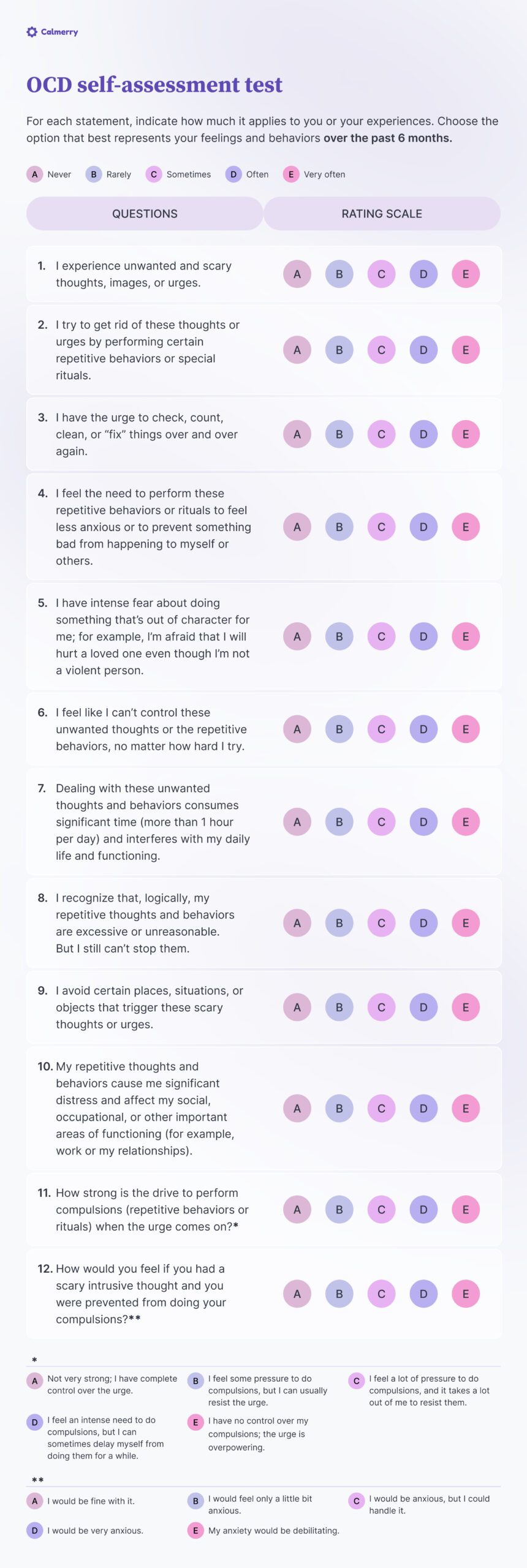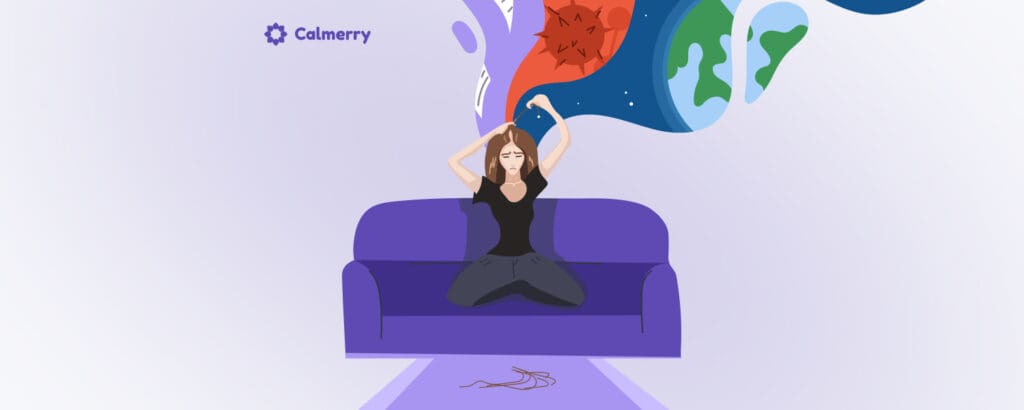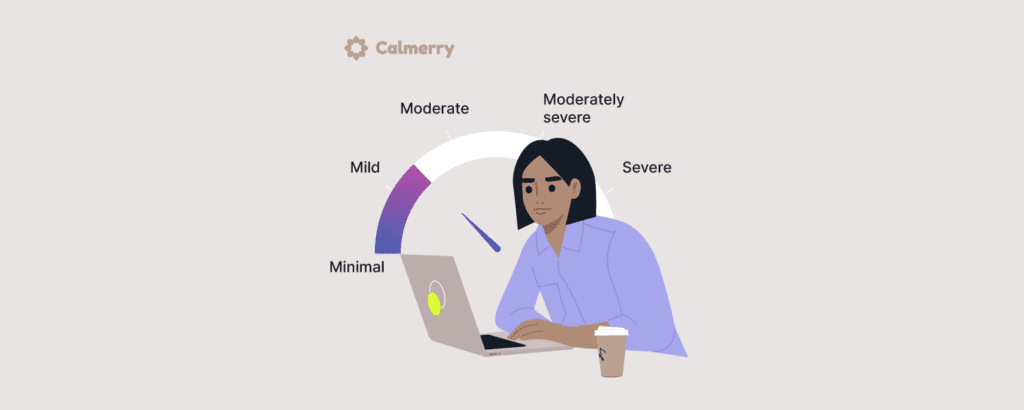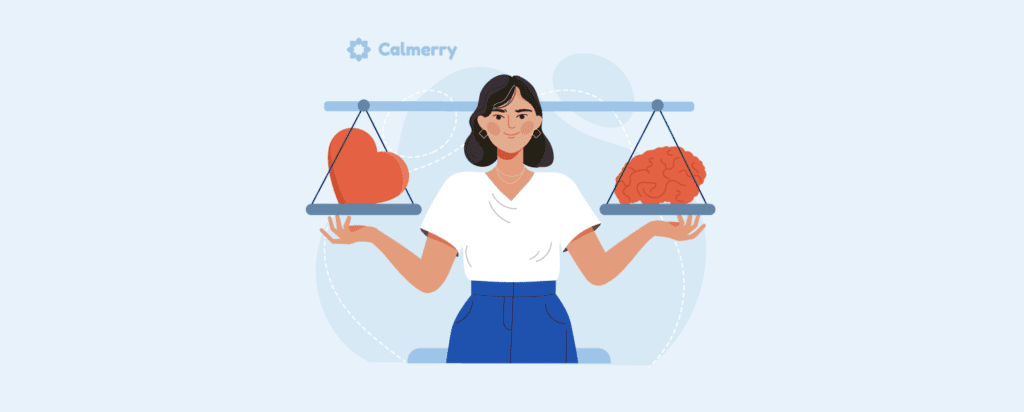OCD Test: Online Self-Assessment

In this article
Obsessive-compulsive disorder is a serious mental health condition that causes people to experience unwanted thoughts and the strong urge to perform repetitive behaviors. It affects around 1% of the population.
People with OCD have two core symptoms. Obsessions are intrusive thoughts, urges, or images that cause overwhelming fear and anxiety. People with OCD respond to these obsessions with compulsions, which are repetitive or ritualistic behaviors. They often lose hours of each day to compulsive behaviors, but can’t stop doing them no matter how hard they try.
Getting the OCD treatment you deserve begins with determining your eligibility for a diagnosis. Unfortunately, it can take as long as 17 years for people with OCD to receive the right diagnosis. [1] Ziegler, S., Bednasch, K., Baldofski, S., & Rummel‐Kluge, C. (2021). Long durations from symptom onset to diagnosis and from diagnosis to treatment in obsessive-compulsive disorder: A retrospective self-report study. PLOS ONE, 16(12), e0261169. https://doi.org/10.1371/journal.pone.0261169
By taking this preliminary OCD screening, you’re taking the first step to getting a diagnosis and equipping yourself with the tools to advocate for yourself.
Our online OCD test provides initial insights into whether you might be experiencing symptoms of OCD and offers guidance on the appropriate steps to take if you suspect you may have it.
OCD self-assessment test
For each statement, indicate how much it applies to you or your experiences. Choose the option that best represents your feelings and behaviors over the past six months.

1) I experience unwanted and scary thoughts, images, or urges.
A. Never
B. Rarely
C. Sometimes
D. Often
E. Very often
2) I try to get rid of these thoughts or urges by performing certain repetitive behaviors or special rituals.
A. Never
B. Rarely
C. Sometimes
D. Often
E. Very often
3) I have the urge to check, count, clean, or “fix” things over and over again.
A. Never
B. Rarely
C. Sometimes
D. Often
E. Very often
4) I feel the need to perform these repetitive behaviors or rituals to feel less anxious or to prevent something bad from happening to myself or others.
A. Never
B. Rarely
C. Sometimes
D. Often
E. Very often
5) I have intense fear about doing something that’s out of character for me; for example, I’m afraid that I will hurt a loved one even though I’m not a violent person.
A. Never
B. Rarely
C. Sometimes
D. Often
E. Very often
6) I feel like I can’t control these unwanted thoughts or the repetitive behaviors, no matter how hard I try.
A. Never
B. Rarely
C. Sometimes
D. Often
E. Very often
7) Dealing with these unwanted thoughts and behaviors consumes significant time (more than 1 hour per day) and interferes with my daily life and functioning.
A. Never
B. Rarely
C. Sometimes
D. Often
E. Very often
8) I recognize that, logically, my repetitive thoughts and behaviors are excessive or unreasonable. But I still can’t stop them.
A. Never
B. Rarely
C. Sometimes
D. Often
E. Very often
9) I avoid certain places, situations, or objects that trigger these scary thoughts or urges.
A. Never
B. Rarely
C. Sometimes
D. Often
E. Very often
10) My repetitive thoughts and behaviors cause me significant distress and affect my social, occupational, or other important areas of functioning (for example, work or my relationships).
A. Never
B. Rarely
C. Sometimes
D. Often
E. Very often
11) How strong is the drive to perform compulsions (repetitive behaviors or rituals) when the urge comes on?
A. Not very strong; I have complete control over the urge.
B. I feel some pressure to do compulsions, but I can usually resist the urge.
C. I feel a lot of pressure to do compulsions, and it takes a lot out of me to resist them.
D. I feel an intense need to do compulsions, but I can sometimes delay myself from doing them for a while.
E. I have no control over my compulsions; the urge is overpowering.
12) How would you feel if you had a scary intrusive thought and you were prevented from doing your compulsions?
A. I would be fine with it.
B. I would feel only a little bit anxious.
C. I would be anxious, but I could handle it.
D. I would be very anxious.
E. My anxiety would be debilitating.
Who is the quiz for?
This free OCD screening tool is for anyone who believes they could benefit from an OCD assessment and diagnosis.
The first step to treatment is getting a professional evaluation. Although this online OCD quiz isn’t an official assessment, your answers can give you some insight into whether what you’re going through could be signs of OCD.
Is the test accurate?
Calmerry has created this preliminary screening tool based on the Diagnostic Statistical Manual, 5th Edition, as well as the Yale-Brown Obsessive-Compulsive Scale. [2] Goodman, W. K. (1989). The Yale-Brown obsessive compulsive scale. Archives of General Psychiatry, 46(11), 1006. https://doi.org/10.1001/archpsyc.1989.01810110048007
However, please note that this assessment isn’t intended to be a diagnostic tool and cannot provide definitive answers about whether or not you have OCD. The only way to get an accurate assessment of your mental health is to speak with a qualified mental health provider.
How to take the test and interpret the results
Read each question and choose the answer that you feel most accurately describes your symptoms and experiences. Once you have finished, count the number of “A” responses you chose, the number of “B” responses, and so on through “E” responses.
If you have more “D” or “E” responses than “A” or “B” responses, then it could be a sign that you meet the criteria for an OCD diagnosis.
Again – no online OCD quiz can provide any definitive answers about whether you live with OCD. But if you answered “D” or “E” to many questions, then you could benefit from further evaluation and treatment.
List of clinically validated OCD tests for adults
An OCD evaluation is often done through a clinical interview, which means that a mental health professional will ask thorough questions to explore your symptoms and how they affect your day-to-day life.
In addition, there are a few different clinically validated OCD tests that mental health providers may administer themselves or ask you to take on your own. [3] Rapp, A. M., Bergman, R. L., Piacentini, J., & McGuire, J. F. (2016). Evidence-Based Assessment of Obsessive–Compulsive Disorder. Journal of Central Nervous System Disease, 8, JCNSD.S38359. https://doi.org/10.4137/jcnsd.s38359
Yale-Brown Obsessive Compulsive Scale (Y-BOCS)
The Y-BOCS is considered the “gold standard” in clinician-rated screening tools for OCD in adults (its counterpart, the CY-BOCS, is used for children). [2] Goodman, W. K. (1989). The Yale-Brown obsessive compulsive scale. Archives of General Psychiatry, 46(11), 1006. https://doi.org/10.1001/archpsyc.1989.01810110048007
This assessment tool includes 2 parts: one to measure symptom severity and one to take inventory of specific types of obsessions and compulsions the person experiences.
It’s an extensive assessment, totaling 68 questions.
There is also a self-rated version of this test in which clients answer the questions themselves rather than getting assessed by a mental health provider.
Florida Obsessive-Compulsive Inventory
The Florida Obsessive-Compulsive Inventory is a self-rating scale with 12 questions. [4] Storch, E. A., Bagner, D. M., Merlo, L. J., Shapira, N. A., Geffken, G. R., Murphy, T. K., & Goodman, W. K. (2007). Florida obsessive-compulsive inventory: Development, reliability, and validity. Journal of Clinical Psychology, 63(9), 851–859. https://doi.org/10.1002/jclp.20382
Using this screening tool, people answer if they’ve never experienced the symptom, are currently experiencing the symptom, or have experienced the symptom in the past.
Dimensional Obsessive-Compulsive Scale (DOCS)
The DOCS is a self-rating scale that asks about specific dimensions of OCD symptoms. [5] Rosario, M. C. D., Miguel, E. C., Quatrano, S., Chacon, P., Ferrão, Y. A., Findley, D. B., Katsovich, L., Scahill, L., King, R. A., Woody, S. R., Tolin, D. F., Hollander, E., Kano, Y., & Leckman, J. F. (2006). The Dimensional Yale–Brown Obsessive–Compulsive Scale (DY-BOCS): an instrument for assessing obsessive–compulsive symptom dimensions. Molecular Psychiatry, 11(5), 495–504. https://doi.org/10.1038/sj.mp.4001798
There are 20 questions that ask about different OCD themes such as contamination and germs, responsibility for harm and injury, symmetry, and so on.
Obsessive-Compulsive Inventory-Revised (OCI-R)
The OCI-R is the newer version of the OCI; there are 18 questions that clients rate on a 5-point scale. [6] Huppert, J. D., Walther, M., Hajcak, G., Yadin, E., Foa, E. B., Simpson, H. B., & Liebowitz, M. R. (2007). The OCI-R: Validation of the subscales in a clinical sample. Journal of Anxiety Disorders, 21(3), 394–406. https://doi.org/10.1016/j.janxdis.2006.05.006 This creates 6 subscales, which ask about different OCD themes like washing, counting, and so on.
After the OCD test: Next steps
If this OCD test helped you to realize that you could have OCD, then it’s important not to wait to schedule a professional assessment with a qualified mental health provider.
Talking with a therapist can give you answers and information that can help explain the emotional torment you’ve been going through with OCD. They can provide (or point you toward) effective OCD treatment that can help you get your life back.
At Calmerry, we have qualified OCD specialists who use evidence-based methods to help you overcome the seemingly never-ending cycle of obsessions and compulsions.
You could be matched with a licensed OCD therapist within an hour.
Get the answers and support you’ve been waiting for. Try online therapy with Calmerry!
Ziegler, S., Bednasch, K., Baldofski, S., & Rummel‐Kluge, C. (2021). Long durations from symptom onset to diagnosis and from diagnosis to treatment in obsessive-compulsive disorder: A retrospective self-report study. PLOS ONE, 16(12), e0261169. https://doi.org/10.1371/journal.pone.0261169
Goodman, W. K. (1989). The Yale-Brown obsessive compulsive scale. Archives of General Psychiatry, 46(11), 1006. https://doi.org/10.1001/archpsyc.1989.01810110048007
Rapp, A. M., Bergman, R. L., Piacentini, J., & McGuire, J. F. (2016). Evidence-Based Assessment of Obsessive–Compulsive Disorder. Journal of Central Nervous System Disease, 8, JCNSD.S38359. https://doi.org/10.4137/jcnsd.s38359
Storch, E. A., Bagner, D. M., Merlo, L. J., Shapira, N. A., Geffken, G. R., Murphy, T. K., & Goodman, W. K. (2007). Florida obsessive-compulsive inventory: Development, reliability, and validity. Journal of Clinical Psychology, 63(9), 851–859. https://doi.org/10.1002/jclp.20382
Rosario, M. C. D., Miguel, E. C., Quatrano, S., Chacon, P., Ferrão, Y. A., Findley, D. B., Katsovich, L., Scahill, L., King, R. A., Woody, S. R., Tolin, D. F., Hollander, E., Kano, Y., & Leckman, J. F. (2006). The Dimensional Yale–Brown Obsessive–Compulsive Scale (DY-BOCS): an instrument for assessing obsessive–compulsive symptom dimensions. Molecular Psychiatry, 11(5), 495–504. https://doi.org/10.1038/sj.mp.4001798
Huppert, J. D., Walther, M., Hajcak, G., Yadin, E., Foa, E. B., Simpson, H. B., & Liebowitz, M. R. (2007). The OCI-R: Validation of the subscales in a clinical sample. Journal of Anxiety Disorders, 21(3), 394–406. https://doi.org/10.1016/j.janxdis.2006.05.006
online therapy
live video session



